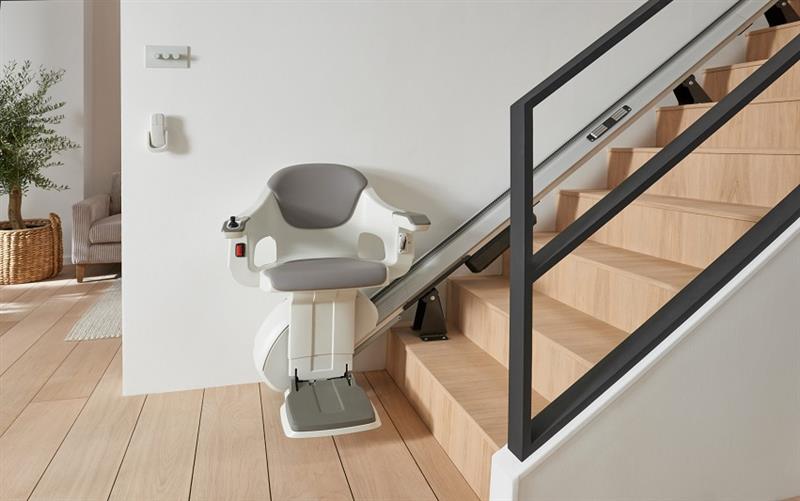
Whether to rent or buy a stairlift for your home depends on several factors including your short-term and long-term mobility needs, budget constraints, and homeownership status.
Renting a stairlift is advantageous for short-term requirements, offering lower upfront costs, included maintenance, and flexibility to return the equipment once it's no longer needed. On the other hand, buying a stairlift is more cost-effective in the long run for extended or permanent use, providing customization options, ownership benefits, and potentially adding value to your property.
When considering whether to rent or buy a stairlift for your home, several factors come into play. Here's a breakdown to help you determine which option might be the best fit for your situation:
Renting a Stairlift:
- Short-Term Need: If you only need a stairlift for a temporary period, such as during post-surgery recovery or while a family member is visiting, renting might be the most cost-effective solution. Renting is beneficial if you only require a stairlift for a limited time, such as during a temporary recovery period or when accommodating a visiting family member who has mobility issues. Since the need is short-lived, renting can save you money compared to buying outright.
- Lower Upfront Costs: Renting typically involves lower initial costs compared to buying a stairlift outright. This can be advantageous if you're on a tight budget or unsure about the long-term need for a stairlift. Renting typically involves lower initial costs because you're essentially leasing the stairlift for a specific duration. This can be advantageous if you're on a tight budget or unsure about the long-term necessity of a stairlift in your home.
- Maintenance Included: Rental agreements often include maintenance and servicing as part of the package, relieving you of the responsibility of repairs and upkeep. Rental agreements often include maintenance and servicing as part of the package. This means you won't have to worry about arranging repairs or paying for maintenance separately, as it's usually covered by the rental company.
- Flexibility: Renting provides flexibility, allowing you to return the stairlift once you no longer need it without any further commitments. Renting offers flexibility because you can return the stairlift once it's no longer needed, without any further obligations. This is useful if your circumstances change or if you're unsure about your future mobility needs.
Buying a Stairlift:
- Long-Term Need: If you anticipate needing a stairlift for an extended period, purchasing might be more cost-effective in the long run. It eliminates the ongoing rental payments, making it a more economical choice over time. Buying a stairlift is more cost-effective in the long run if you anticipate needing it for an extended period. While the initial investment is higher than renting, you won't have ongoing rental payments, making it a better financial choice over time.
- Customization: Buying allows you to customize the stairlift to your exact specifications and preferences, ensuring it perfectly fits your staircase and meets your specific needs. Purchasing allows you to customize the stairlift to fit your staircase perfectly and meet your specific needs. You can choose features such as seat type, track length, and additional safety options to ensure optimal comfort and usability.
- Investment: While initially more expensive than renting, buying a stairlift can be seen as an investment in your home's accessibility and your long-term comfort and independence. Buying a stairlift can be viewed as an investment in your home's accessibility and your long-term comfort and independence. It adds value to your property and provides a permanent solution for overcoming mobility challenges.
- Ownership: Owning a stairlift provides a sense of ownership and control over the equipment. You can use it as needed without worrying about rental agreements or estrictions. When you buy a stairlift, you own the equipment outright. This gives you full control over its usage and allows you to use it as needed without any restrictions or concerns about rental agreements.
Factors to Consider:
- Cost: Compare the total costs of renting versus buying over your anticipated period of need to determine which option is more economical. Compare the total costs of renting versus buying over your anticipated period of need. Take into account upfront expenses, ongoing rental payments, maintenance costs, and potential resale value if you choose to buy.
- Duration of Use: Consider how long you'll need the stairlift. If it's only for a short period, renting might be more practical. For longer-term use, buying could be a better investment. Consider how long you'll need the stairlift. If it's only for a short period, renting might be more practical. For longer-term use, buying could be a better investment.
- Future Needs: Assess your future needs and whether they might change. If there's a possibility of needing the stairlift again in the future, buying might be a wiser choice. Think about potential changes in your mobility needs over time. If there's a possibility of requiring the stairlift again in the future, buying may be a more prudent choice.
- Homeownership: If you own your home, buying a stairlift adds value to your property. Renting may be more suitable for renters or those in temporary living situations. If you own your home, buying a stairlift adds permanent value to your property. Renting may be preferable for renters or individuals in temporary living situations.